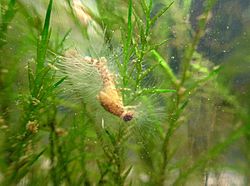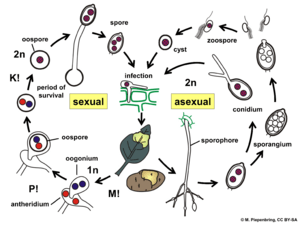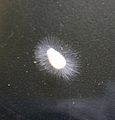Oomycete facts for kids
Quick facts for kids Oomycetes |
|
|---|---|
 |
|
| Scientific classification | |
| Kingdom: | |
| Phylum: | |
| Class: |
Oomycetes
|
Oomycetes (say: oh-oh-MY-seats) are tiny living things, so small you need a microscope to see them! They belong to a big group of eukaryotic microorganisms called Heterokonts. Even though they might look like fungi, they are actually a different group of organisms.
Like fungi, Oomycetes get their food from other sources. They can be saprophytic, meaning they feed on dead plants or animals. They can also be pathogenic, which means they cause diseases in living things. Some Oomycetes have long, thin parts called filaments, similar to fungi. These filaments usually do not have many internal walls, called septa.
Oomycetes can make copies of themselves in two ways: sexually and asexually. They are known for being very strong pathogens of plants. They cause serious plant diseases like potato blight and sudden oak death.
People often call Oomycetes "water moulds." This name came about because some species live in water. However, many Oomycetes actually live on land and cause diseases in plants there.
Reproduction
Most Oomycetes make two main kinds of spores. Spores are like tiny seeds that help the organism spread.
One type is an asexual spore called a zoospore. These zoospores can move on their own. They often swim in surface water, moving towards things like food sources. This movement is called chemotaxis. Some Oomycetes also make asexual spores that the wind carries to new places.
The other type of spore is a sexual spore, called an oospore. These oospores are usually clear and round. They have a strong, double wall. This tough wall helps them survive when conditions are bad, like when it's too dry or too cold.
Images for kids
-
A sign of late blight on the underside of a potato leaf.
See also
 In Spanish: Oomicetos para niños
In Spanish: Oomicetos para niños








